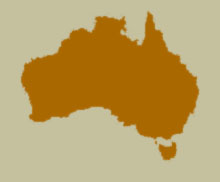Synonyms
Bucolus cirrhosus Slipinski and Dolambi, 2007:766.
Diagnosis
This species is quite distinctive due to its habitus strongly resembling Cryptolaemus but with anteriorly prominent prosternal lobe, very broad tibiae and narrow elytral epipleura.
Description
Length 3.5-4.0 mm. Head, pronotum and most of the ventral side orange; elytra dark brown with orange apices; mouthparts, antennae, tarsi and abdomen yellowish. Dorsum moderately convex, covered with rather short, whitish pubescence forming distinct whorled pattern on elytra. Punctures on head distinctly finer than eye facets, separated by 1.0-2.0 diameters; intervals between punctures shiny without microsculpture. Anterior clypeal margin straight. Antenna slender with broad club. Apical maxillary palpomere slightly longer than broad, ovoid. Eyes at frons separated by about 2.3 times eye width. Pronotal base not margined; prosternum long in front of procoxae with large and forward oriented, setose projection that is about 0.5 times as broad as prosternum. Prosternal process 0.4 times as wide as transverse coxal diameter. Hypomeron deeply concave but without distinct foveae. Scutellum triangular, setose. Elytral surface densely, irregularly punctate; all punctures of similar size, setigerous and 2-3 diameters apart; interspaces shiny and without noticeable microsculpture. Epipleuron narrow, about as broad as metepisternum, strongly narrowing posteriorly from the level of abdomen and completely absent apically; foveae well defined; mesofemoral fovea delimited both on metepisternum and epipleuron, metafemoral fovea deeply delimited on a very narrow epipleuron. Meso-metaventral junction about as wide as mesocoxa; mesoventrite straight and bordered anteriorly. Protibia short and broad, weakly emarginate along external margin of deep tarsal groove; mid and hind tibiae similar to each other, narrower and sharply angulated externally; claws appendiculate with basal tooth prominent and short. Abdominal postcoxal line recurved and incomplete; ventrite V weakly emarginate medially.
Male
Male genitalia as figured.
Female
Externally identical to male.
Variation
Not observed.
 Distribution and Biology
Distribution and Biology
Known from a single locality in southern New South Wales.
Species References
Slipinski, A and Dolambi, F. 2007. Revision of the Australian Coccinellidae (Coleoptera). Part 7. Genus Bucolus Mulsant. Annales Zoologici (Warszawa), 57: 763-781.
[ Top ]
